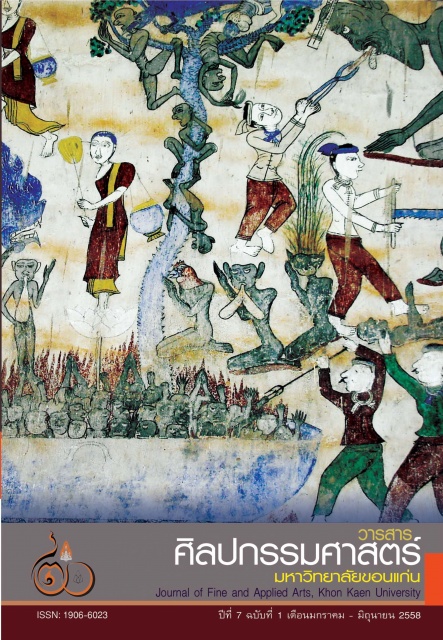การพัฒนาทักษะการดีดจะเข้ นักเรียนสาขาเครื่องสายไทย(จะเข้) โดยใช้เพลงฉิ่งมุล่ง 7 บันไดเสียง ของรองศาสตราจารย์ปกรณ์ รอดช้างเผื่อน The Skills' Development of Students Major in Thai String Music (Ja-Khe), Using Associate Professor Pakron Rodchangphuen's a Sev
Main Article Content
Abstract
การวิจัยเรื่อง “การพัฒนาทักษะการดีดจะเข้ นักเรียนสาขาเครื่องสายไทย (จะเข้) โดยใช้เพลงฉิ่งมุล่ง ๗ บันไดเสียงของรองศาสตราจารย์ปกรณ์ รอดช้างเผื่อน” มีวัตถุประสงค์เพื่อสังเคราะห์รูปแบบเพลงฉิ่งมุล่ง ๗ บันไดเสียง และเพื่อพัฒนาทักษะการดีดจะเข้ นักเรียนสาขาเครื่องสายไทย (จะเข้) โดยใช้เพลงฉิ่งมุล่ง ๗ บันไดเสียง ประกอบด้วยบันไดเสียง ที มี ลา เร ซอล โด และ ฟา ใช้กระบวนการวิจัยเชิงพัฒนา ดำเนินการระหว่างเดือนเมษายน – กันยายน ๒๕๕๖ มีผลการวิจัย ดังนี้
รูปแบบของเพลงฉิ่งมุล่ง ๗ บันไดเสียง มีการเปลี่ยนบันไดเสียงเป็นคู่ ๔ ยึดตามขนบแต่โบราณ สำนวนกลอนมีความคล้ายคลึงกันทั้งสามท่อน แต่ร้อยเรียงให้แตกต่างกัน มีความเคลื่อนไหวของเสียงกระโดดข้ามไปมา มีการใช้สำนวนแบบโบราณ และมีการนำสำนวนกลอนของเครื่องดนตรีชนิดอื่นเข้ามาหลายทำนอง มีการใช้นิ้วครบทุกนิ้ว และเพิ่มการใช้ท้องนิ้วในบางทำนอง มีการใช้ไม้ดีด ในลักษณะที่หลากหลาย ครอบคลุมทุกสาย ทุกนมจะเข้ ใช้กลวิธีการดีดจะเข้ที่เป็นเอกลักษณ์ของจะเข้อย่างครบถ้วน รวมทั้งนำกลวิธีพิเศษที่ใช้ในการบรรเลงเพลงเดี่ยวเข้ามาร่วมด้วย
การพัฒนาทักษะการดีดจะเข้ของนักเรียนสาขาเครื่องสายไทย โดยใช้เพลงฉิ่งมุล่ง ๗ บันไดเสียง มีผลให้ผู้เข้าร่วมโครงการพัฒนาทักษะ เรียนรู้เรื่องการเปลี่ยนบันไดเสียง สำนวนกลอนเพลง การใช้นิ้ว การใช้ไม้ดีด และกลวิธีการดีดจะเข้ เป็นจำนวนมากตามจำนวนบันไดเสียง การไล่มืออย่างต่อเนื่องทั้ง ๗ บันไดเสียง เป็นระยะเวลานาน ทำให้เกิดสมาธิ มีความอดทน มีกำลังแขน กำลังมือ กำลังนิ้ว เกิดความคล่องตัวในเชิงทักษะปฏิบัติ ในการใช้นิ้ว การใช้ไม้ดีด การเปลี่ยนบันไดเสียง สำนวนกลอน และกลวิธีการดีดจะเข้ต่างๆ เกิดประสบการณ์การบรรเลง สามารถบรรเลงในวงเครื่องสายปี่ชวา และบรรเลงเพลงเดี่ยวได้เป็นอย่างดี
The research, 'The Skills' Development of Students Major in Thai String Music (Ja-Khe), Using Associate Professor Pakron Rodchangphuen's a Seven-Tune-Scale-song: Ching-Mu-Long’, aims to synthesise music formats of a seven-tune-scale-song: Ching-Mu-Long, and to develop students’ major in Thai string music abilities (Ja-Khe). The song comprises of Ti, Mi, La, Re, Sol, Do, and Fa scales. The research was conducted during the period of April - September 2013 by employing research and development method. The research findings are as follows.
A ‘seven-tune-scale-song Ching-Mu-Long’ changes a tune scale in a pair of four’s format, as is done traditionally. The song has three sections which have similar melodies; however, they are expressed differently. The song melodies have a movement of sound from a tune to others, with a traditional expression. Furthermore, there is also the use of melodies belong to other music instruments in the song. To play the song requires movements from all of the hands’ fingers, an increase in movements of some inner part of fingers, and Ja-Khe’s stick; in a wide range that covers all the strings and the joins of Ja-Khe. Moreover, to play the song also includes the special techniques used to play Ja-Khe and other Pleang-Diew.
The skills' development of students major in Thai string music (Ja-Khe), Using Associate a seven-tune-scale-song: Ching-Mu-Long, helps participants develop their skills in various aspect as follows: learning the steps to change the tunes, learning about the song’s melodies; learning the steps to play Ja-Khe using their fingers and a Ja-Khe stick; learning how to play Ja-Khe with numerous tunes. Furthermore, having the participants changing the song’s seven tune-scales continuously also lead them to concentration, patient, greater fingers and hands strength, greater flexibility in practical skills using fingers and a Ja’Khe stick, greater Ja-Khe’s tactics. Furthermore, the participants also gain an extensive music experience in terms of practical skills to be used in other string music, Pi-Chawa music and Pleang-Diew.
Article Details
Content and information in articles published in the Journal of Fine and Applied Arts of Khon Kaen University is regarded as the opinion and sole responsibility of the author(s) directly; therefore, editors are not obliged to agree to or share any responsibility with regard to the content and information that appears within these articles.
All articles, information, content, image, etc. that have been published in the Journal of Fine and Applied Arts of Khon Kaen University is the copyright of the Journal of Fine and Appllied Arts of Khon Kaen University. Any person or organization who wishes to distribute all or parts of the articles for further dissemination or other usage must first receive permission from the Journal of Fine and Applied Arts of Khon Kaen University before proceeding to do so.


